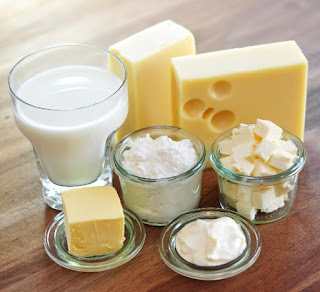What Are Antioxidants? || Are Antioxidants Really Good For Anything?|| *INFORMATION *
ANTIOXIDANTS
USDA definition of an antioxidant can be extended in a nutrition context to include "compounds that protect biological systems against the potentially harmful effects of processes or reactions that can cause excesive oxidations".ANTIOXIDANT DEFENCE SYSTEMS
Antioxidant defence system of the body consists of endogenous and exogenous antioxidants, which work together at the the molecular level to protect cell membranes, lipo proteins, DNA & RNA from the damaging effects of free radicals. Exogenous antioxidants are nutrients such as ascorbic acid, tocopherols and beta-carotene and non nutrients obtained through intake of different diets.Some antioxidants are synthesized by cells (endogenous), and others need to be provided by the diet.
DIETARY ANTIOXIDANTS :
They are classified by -A. Nutrient.
• Beta carotene - Pro Vitamin A.
• Ascorbic acid - Vitamin C.
• Tocopherols.
• Tocotrienols.
• Riboflavin.
• Sulphur Amino Acids : cysteine and methionine ok.
• Selenium.
B. Non-nutrients :
• Carotenoids (lycopene, xanthophylls).
• Lutein, alpha and gamma carotenes (crypto xanthene, zeaxanthin).
• Flavonoids (quercetin, myricetin, quercetagatin, gossypetin).
• Anthocyanins.
• Isoflavones.
• Phenolic Compounds (catechin)
• Indoles.
ANTIOXIDANTS AND DISEASE :
• Cataract :- cataract is the impairment in the vision caused due to the loss of transparency in lens.Antioxidant status is slow in people with cataract. Antioxidants status can be assessed by measuring the levels of enzymes like catalyse, superoxide dismutase and glutathione peroxidase. Cataract patients have lower intake of antioxidants such as beta carotene, riboflavin, ascorbic acid and Minerals such as copper,zinc and manganese.
• Cancer :- Dietary deficiencies of selected antioxidant micronutrients like - beta carotene, Vitamin C, vitamin E, Selenium and their association with known risk factors in the pathogenesis and potential prevention of various cancers. Concurrent correction of sub optimal plasma antioxidant levels maybe important part of optimum nutrition that help to prevent early stages of cancer.
• PEM :- Oedema is a typical clinical feature of kwashiorkor. Copper as a constituent of the body, play an important role in the aeitology of Oedema in kwashiorkor. Plasma Copper and it's ceruloplasmin and RBC superoxide dismutase are significantly decreased in marasmic - kwashiorkor children compare two to normal and marasmic children.
• Neurological Conditions :- alpha tocopherol has been found to be useful in slowing the progression of moderately severe Alzheimer's. Antioxidants in foods have been shown to be effective in maintaining memory, folate, Vitamin C and beta carotene seem to be the best protective agents that are present in fruits and vegetables.
• Cardiovascular Disease :- Two dietary components that affects the oxidation protein shall of LDL cholesterol are the level of linoleic acid in the particle and the availability of antioxidants. Vitamin E is the the most concentrated antioxidant carried on LDL, the amount being 20 to 300 times greater than any other antioxidants. A major function of Vitamin E is to prevent oxidation of PUFA in the cell membrane.
SOURCES
• Whole grains :Selenium is present as selenomethionine in cereals and millets. Among cereals, Selenium content is more in jowar and bajra. Whole grains contain phenolic compounds such as - ferulic, caffeic acid and phytic acid.
• Pulses :
Phytoestrogen found in soybean is a ployplenolic compound and anticarcinogenic effect on the breast tissue and positive effects on the lipoprotein profile and bone density.
Pulses like red gram, green gram and bengal gram are rich source of Selenium.
• Red Wine :
In red wine, flavonols form part of a wider group of Antioxidant chemicals called polyphenols.
• Tea & Coffee :
Polyphenols like Chlorogenic acid present in coffee beans and tea leaves are antioxidants.
Polyphenols can stop the damage that free radicals do to cells, neutralize enzymes essential for tumor growth and deactivate cancer promoters.
• Fruits & Vegetables :
a. Red grapes and pomegranates contribute to antioxidants due to the presence of anthocyanins.
b. Apple content polyphenols, prevents heart attack.
c. Green leafy vegetables are exceptionally rich source of beta-carotene, that can inhibit atherosclerosis and prevent heart disease.
d. Cooked tomatoes are associated with greater health benefit, compare two uncooked. It reduced risk of many cancer and protection against heart attacks.
Watermelon, Tomatoes & Pink Grapes are rich in lycopene.
e. Red onions are rich in flavonols.

f. Strawberries, raspberries, blackberrys contain polyphenol.
g. Sulforaphane in broccoli has cancer preventive properties.
• Oils :
Rice Bran oil contains a high amount of unsaponifiable components such as tocotrienols and oryzanol.
• Whey Proteins :
Whey protein contains glutathione and inhibiting the growth of several types of tumor.
• Nuts :
Nuts are sources of phytosterols and other phytochemical compounds with potential serum cholesterol modulating effects.
a. Red grapes and pomegranates contribute to antioxidants due to the presence of anthocyanins.
c. Green leafy vegetables are exceptionally rich source of beta-carotene, that can inhibit atherosclerosis and prevent heart disease.
Watermelon, Tomatoes & Pink Grapes are rich in lycopene.
e. Red onions are rich in flavonols.

f. Strawberries, raspberries, blackberrys contain polyphenol.
• Oils :
Rice Bran oil contains a high amount of unsaponifiable components such as tocotrienols and oryzanol.
• Whey Proteins :
Whey protein contains glutathione and inhibiting the growth of several types of tumor.
Nuts are sources of phytosterols and other phytochemical compounds with potential serum cholesterol modulating effects.






















Nice Information 👍👌
ReplyDelete